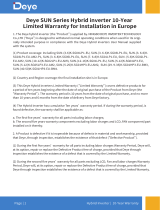The battery product is not fully charged. It is recommended that the installation be com-
pleted within 3 months after arrival;
During the maintenance process, do not re-install the battery in the battery product. Oth-
erwise, the performance of the battery will be reduced;
It is forbidden to dismantle any battery in the battery product, and it is forbidden to dis-
sect the battery;
After the battery product is over-discharged, it is recommended to charge the battery
within 48 hours. The battery product can also be charged in parallel. After the battery
product is connected in parallel, the charger only needs to connect the output port of any
product battery.
Never attempt to open or dismantle the battery! The inside of the battery does not con-
tain serviceable parts.
Disconnect the Li-Ion battery from all loads and charging devices before performing
cleaning and maintenance activities
Place the enclosed protective caps over the terminals before cleaning and maintenance
activities to avoid the risk of contacting the terminals.
6.2
Inspection
Inspect for loose and/or damaged wiring and contacts, cracks, deformations, leakage, or
damage of any other kind. If damage to the battery is found, it must be replaced. Do not
attempt to charge or use a damaged battery. Do not touch the liquid from a ruptured
battery.
Regularly check the battery’s state of charge. Lithium Iron Phosphate batteries will slowly
self-discharge when not in use or whilst in storage.
Consider replacing the battery with a new one if you note either of the following condi-
tions:
- The battery run time drops below 70% of the original run time.
- The battery charge time increases significantly.
6.3
Cleaning
If necessary, clean the Li-Ion battery with a soft, dry cloth. Never use liquids, solvents, or
abrasives to clean the Li-Ion battery.
6.4
Maintenance
The Li-Ion battery is maintenance free. Charge the battery to approximately > 80% of its ca-
pacity at least once every year to preserve the battery
’
s capacity.
6.5
Storage
The battery product should be stored in a dry, cool, and cool environment;
Generally, the maximum storage period at room temperature is 6 months. When the bat-
tery is stored over 6 months, it is recommended to check the battery voltage. If the volt-
age is higher than 51.2V, it can continue to store the battery. In addition, it is needed to























